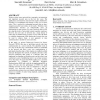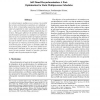488 search results - page 2 / 98 » On the significance of synchroneity in emergent systems |
SENSYS
2003
ACM
13 years 10 months ago
2003
ACM
Wireless ad-hoc sensor networks have emerged as an interesting and important research area in the last few years. The applications envisioned for such networks require collaborati...
OSDI
1996
ACM
13 years 6 months ago
1996
ACM
Non-blocking synchronization has significant advantages over blocking synchronization: however, it has not been used to a significant degree in practice. We designed and implement...
APSEC
2008
IEEE
13 years 7 months ago
2008
IEEE
Reactive systems are often described by interconnecting sub-components along architectural connectors defining communication policies. Generally, such global systems may exhibit p...
IPPS
1996
IEEE
13 years 9 months ago
1996
IEEE
In a shared-memory multiprocessor system, it is possible that certain synchronization operations are redundant -that is, their corresponding sequencing requirements are enforced c...
ISCA
1993
IEEE
13 years 9 months ago
1993
IEEE
We evaluate the e ect of processor speed, network bandwidth, and software overhead on the performance of release-consistent software distributed shared memory. We examine ve di er...


